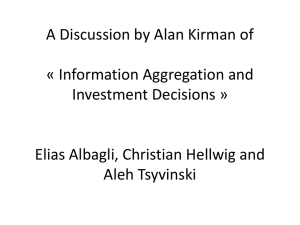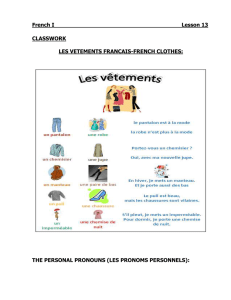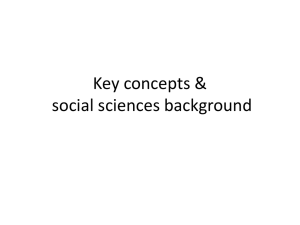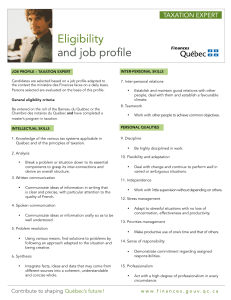The Experiment
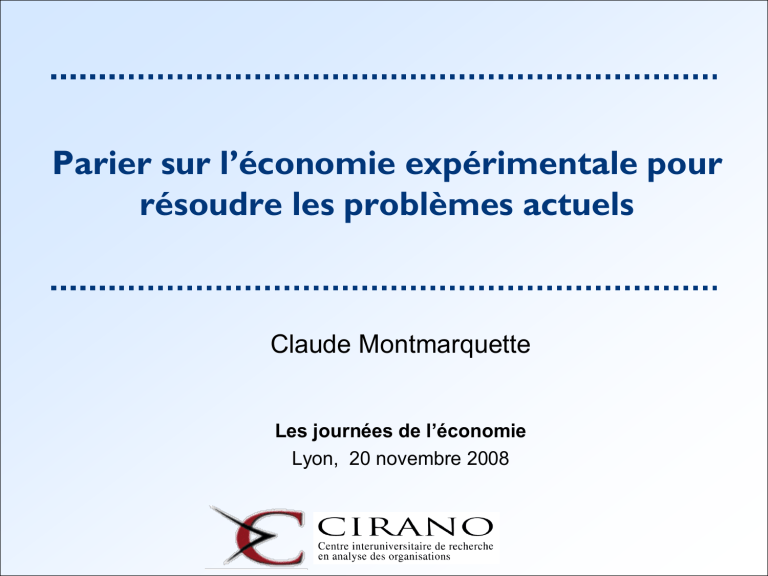
Parier sur l’économie expérimentale pour résoudre les problèmes actuels
Claude Montmarquette
Les journées de l’économie
Lyon, 20 novembre 2008
Qu’est-ce que l’économie expérimentale ?
Méthodologie crédible de recherche qui permet de recréer et d’étudier dans un environnement contrôlé en laboratoire :
L’importance de chaque motivation particulière (recherche du gain, besoin de réciprocité, réaction aux changements institutionnels, …) dans la prise de décision des agents.
Sous conditions de risque, d’incertitude ou d’équivalence certaine, permet de tester les hypothèses exactes postulées dans les modèles et d’isoler l’influence de certaines variables. On peut analyser et comprendre l’éventuelle différence qui existe entre les prédictions théoriques à l’équilibre et les résultats tant expérimentaux qu’observés dans la vie quotidienne.
Qu’est-ce que l’économie expérimentale ? (suite)
Rend possible la comparaison entre les environnements, les institutions et les politiques incitatives afin d'en évaluer l’efficacité relative. Cette approche est une plate-forme flexible permettant d’évaluer de nouvelles politiques et de nouveaux
« designs » institutionnels sans avoir à subir les coûts sociaux et privés associés à leur mise en place.
Permet de tester les implications de certaines politiques sociales ou de décisions de gestion sans avoir à réaliser des projets coûteux qui sont plus souvent qu’autrement mis en place avec des paramètres considérés ex post comme ayant
été mal choisis ou spécifiés.
L’économie expérimentale aide à la collecte de données empiriques pertinentes et fiables.
Des distinctions….
• Expériences sur le terrain (field experiments): participation de différentes populations et permet de refléter les choix des individus dans leur milieu et contraintes naturelles
• Expériences naturelles: formidables si possibles; situation peu fréquente et permet peu de traitements
• Trend actuel est de combiner le labo et le terrain
Estce que les résultats obtenus sont transférables dans la réalité ?
Plusieurs réponses :
1. En économie expérimentale, les participants sont payés selon leurs décisions, comme dans la vraie vie. Si c’est le cas, pourquoi existerait-il des différences ?
2. Plusieurs études allant de la réalité vers le laboratoire ou du laboratoire vers la réalité ont prouvé le caractère transférable des résultats.
Aide à la solutions de problèmes actuels
Notons d’entrer de jeu qu’il est impensable de recommander des politiques ou des solutions relativement aux problèmes étudiés sans comprendre les comportements des individus et leurs préférences. l’EE a consacré et continue à le faire beaucoup d’efforts à l’étude des comportements individuels, notamment relativement à leur attitude visà-vis le risque et vis-à-vis leur impatience à consommer.
De quels problèmes peut-il s’agir?
• En principe, la limite des problèmes examinés est lié à l’imagination du chercheur à développer un protocole pertinent. Le défi à cet égard est de réussir à simplifier une situation complexe tout en maintenant la pertinence de l’analyse. L’expertise des analystes et les moyens technologiques disponibles repoussent continuellement les frontières. Historiquement, l’analyse expérimentale est passer de la validation de la théorie des jeux à des applications de politiques liées à la firme, au marché et à l’état.
Exemples de problèmes
• Ressources Naturelles et politique environnementale:
Mise aux enchères des droits d’émission
Marchés concurrentiels d’énergie électrique
• Politique industrielle et réglementaire:
Affection des ressources en espace
Divulgation d’information
Règles fiscales et procédures de vérification
Exemples de problèmes
• Investissement en éducation et en santé
• Politiques de financement de l’état
• Fraudes fiscales
• Marché du travail et participation
• Politiques industrielles
Will the Working Poor Invest in Human
Capital? A Laboratory Experiment by Eckel, Johnson and Montmarquette
SRDC Working Paper 02-01, February 2002
A study sponsored by
Human Resources Development Canada
Key Research Question
Given the right incentive, will the working poor save to invest in human capital?
Objectives of the experiment
Laboratory experiment can be used as a complementary approach to generate valuable information for the design of social experiments
SRDC wanted to shed light on the behaviour and preferences of the working poor with respect to saving for learning activities before launching the learn$ ave demonstration project
Three research questions
• Will the working poor invest in various assets?
• Are these subjects willing to delay consumption for substantial returns?
• How do these subjects view risky choices?
Experimental Instruments
Two instruments:
•
Information questions (43)
Socioeconomic
•
•
Behavioural
Attitudinal
Compensated questions (64)
Compensated Questions - 64
•
Investment Preferences
Cash v. Investment choices
•
Time Preferences
Cash v. Cash later
•
Risk Preferences
Cash v. Risky cash
Sample Compensation Question From the
Experiment
You must choose A or B:
Choice A: $100 one week from today
Choice B: $400 in your own training or education
Investment Preferences
Description of Preference Questions
Questions # Cash
(one week from today)
Own education
Education of family member
Retirement Durable
52
53
54
55
56
57
58
59
60
61
62
63
64
$100.00
$100.00
$100.00
$100.00
$100.00
$166.00
$250.00
$100.00
$250.00
$166.00
$100.00
$500.00
$500.00
$200.00
$600.00
$400.00
$500.00
$600.00
$500.00
$500.00
$500.00
$600.00
$500.00
$500.00
$100.00
$200.00
60.0
50.0
40.0
30.0
20.0
10.0
0.0
Cash vs Own Education
% of participants choosing own education over $100 one week from today
54.6
22.9
43.8
$200 $400
Value of own education expense
$600
Labour Force Participants
% of participants choosing family member’s education over $100 one week from today
30.0
20.0
10.0
0.0
60.0
50.0
40.0
22.4
34.5
47.1
500cd/$250 500cd/$166 $600cd/$100
Non-labour force participants
80.0
70.0
60.0
50.0
40.0
30.0
20.0
10.0
0.0
% of participants choosing education of a family member over cash one week from today
73.3
63.3
53.3
500cd/$250 500cd/$166 $600cd/$100
Ratio of deposit value of certificate of deposit (cd) over cash
What Have We Learned ?
•
In general, the working poor are risk averse and impatient
•
Nevertheless, many can be induced to invest in their own education
•
44 percent accepted offer analogous to learn $ave (3 to 1 match)
•
Overall, own educational expenses was preferred to family member’s education and retirement savings
• not true for non-labour force participants
• Some (16%) couldn’t be induced to invest in any asset even when return approached 500%
What Have We Learned ?
•
The more patient people are, the more likely they are to invest in their own education
•
The more risk-averse subjects are, the less likely they are to invest in their own education.
•
Savings programs may benefit from higher take-up rates if they
•
•
•
Offer high returns
Stress absolute returns
Allow short term savings horizons
Fostering Adult Education: A Laboratory
Experiment on the efficient use of loans, grants and savings incentives by Jonshon, Montmarquette and Eckel
SRDC Working Paper 03-09, December 2003
A study sponsored by
Canada Student Loans Directorate and Applied Research Branch
Human Resources Development Canada
Object of the experiment
To address a particular set of specific policy issues
:
• How do various types of learning subsidies (grants and loans) affect the participation rates in adult education?
• Would the availability of incentives for part-time studies discourage full-time studies?
• What is the extent of windfall gain resulting from different levels and types of financial incentives?
• What are the “barriers” to participation in adult education?
•
Lack of information
• Lack of time
• Loan aversion
• Fear of Failure
• Preference for the present
• Lack of readiness to learn
The Experiment
Focus of the full study is on four sets of measures:
1. Experimental preference measures a) consumption over time b) risky choice alternatives
2. Survey measures: demographics and attitudes
3. Numeracy Assessment
4. Willingness to invest in post-secondary education a) Grants b) Loans (regular and income-sensitive repayment
–
ISR) c) Matched-savings grants
Survey measures
• Demographics
Age, gender, income
• Labor market and educational status
• Attitudinal measures
Planning, debt
• Barriers to education
Skills, dispositional, situational
Example of risk aversion decision
Choice A
$120.00 for sure
Choice B
80% chance for $175 and
20% chance for $0
Summary of Time Preference Choices
Time of Sooner
Payment ($65)
Today
Tomorrow
One Month from today
One year from today
Annualized Later Payment Amount
Rates of Return One Month One Year
Investment Investment
10
20
50
65.27
66.08
67.71
68.25
78.00
97.50
100
200
70.42
75.83
130.00
195.00
Example of Time Preference Decision
Choice A
$65 today
Choice B
$130 one year from today
Cash vs. Investment Choice
Cash alternative made the choice of investment costly to the subject
Results used to calculate elasticities of demand for education with different types of subsidy
Through their choices, subject reveal their preferences for education when financed by:
• Grants
• Loans
• ISR loans
• Matched savings
Figure 1: Example of Education-Preference Decisions
You must choose A or B:
Decision
73
C
HOICE
A
$100 one week from today
$100
C HOICE B
FULL-TIME
Education or Training
(Expenses refunded)
$300 GRANT
$100
$600 GRANT
74
75
Take up Rates for $1,000 in Educational
Financing
0.7
0.6
0.5
0.4
0.3
0.2
0.1
0
Grant
100% Matching Grant
ISR Loan
Loan
Full-time At least part-time
Proportion of urban participants that chose education financing over $100 cash
0.2
0.1
0
0.6
0.5
0.4
0.3
Post-secondary student
$2000 ISR Loan
20% Matching Grant
Unemployed Part-time employed
Labour force attachment
Full-time employed
Determinants of choosing $1000 Grant
Over Cash
(Ordered Probit, 801 observations)
Labour Force attachment
Immigrants, disabled
Willingness to save
(decision)
Positive attitude with respect to Education and
Labor Market
Mathematical Competency
PSE experience
Age
Employee with education supplement
married
Children (older)
HS equivalency
Labor Market Information
Session
• How does information influence
Knowledge?
Attitudes?
Investment?
Labour Market Information
Treatment
Initial experiment
More research?
Yes
Screen
No
No further action
Good general understanding of labour market or received educational compensation
No further action
Relatively poor understanding of labour market
Random assignment
Treatment:
LMI session
Comparison:
No action
Follow-up experiment
What we hope to learn
Overall, Is there evidence of Debt Aversion?
Are certain types of students prone to Debt
Aversion?
Determinants of choosing more education after the LMI session
Probability of choosing more education for the young participants goes up by 15 percentage points or by 33%!
From 42% to 57%
What have we learned?
•
Experimentally measured individual characteristics, such as time preference and risk preferences, can explain variability in the decision making process as much as demographic and social characteristics.
• Overall, participants were sensitive to different levels of incentives and different forms of financing
• LMI interventions can make a difference
Willingness to Borrow:
Using lab experiments to examine debt aversion among Canadian high school students
The Canada Millennium Scholarship Foundation
2008
Research Questions
Does the willingness to borrow vary significantly among types of students?
It is believed that students or potential students belonging to low SES families, Aboriginal families or first generation students’ families are less likely to be willing to borrow (doubt benefits of PSE, low likelihood of success).
How big a problem is debt aversion among these populations?
Are there other socio-economic groups that are more likely to be less willing to borrow?
Proposed Sample
1400 12th graders and CEGEP students
Manitoba, Ontario and Quebec and
Saskatchewan
Aboriginals
Rural/Urban
Low and High SES
Data Collection
Student Survey (web)
Parental Survey (Web or Tel)
Numeracy Assessment
Experimental Measures
Protocol
Info packets delivered to selected schools
Parental Consent
Parental Survey
Students
(pre-session) web survey
In-school Session
($20)
Practice Decisions
Experimental Decisions
Numeracy Assessment
Payoff
Student Survey
Educational ambitions
Expectations with regards to ambitions
Perceived obstacles to pursuing PSE
Financial means at student’s disposal
Debt aversion
Experience with debt
Educational background and experiences
Parent’s education and economic status
Inter-temporal orientation (planning ability)
Attitudes towards risk
Aspiration level
Engagement while in high school
Perceptions of labour market conditions
Perceptions of the cost of, and returns to, PSE
Parental Survey
Expectation and aspirations for children
Education
Income
Family size
Numeracy Assessment
Measures how participants use math in every day life
Most compact way to control for differences in ability among students or schools
Marked inter-student variance that will interact with how they respond to experimental decisions
There is also a more important link numeracy skill is the single most important determinant of both high school completion and PSE participation rates
Experimental Measures
Time Preferences
Risk Preferences
Education Choices
Time Preferences
Binary Decisions organized in increasing reward
6 rates
4 Front End Delays
2 investment or Wait times
48 Decisions
Time Preferences
Earlier
Payoff
$75 tomorrow
One Week
One Month
3 Months
Rate of
Return
0.05
0.1
0.2
0.5
1
2
Later Payment
One Month One Year
75.31
78.75
75.63
76.25
82.50
90
78.13
112.50
81.25
150
87.50
225
Risk Preferences
All Graphical Representations
Two Basic Measures
Holt/Laury
10 binary decisions
Eckel Grossman
1 decsion chosen from SIX 50/50 gambles
(Binary Version of Eckel Grossman)
Education Choices
Basic Design: cash v. Education financing
Use these decisions to distinguish pricing from form of financing
Control for
Size of cash alternative
Price of subsidy per $1 edu financing
Absolute value of edu subsidy
Types of Edu Financing
Grants: $500 - $4000
Loans: $1000 - $4000
Income Contingent Loans
Hybrids (loans + Grants) $800 - $4000
Cash Alternatives: $25 - $700
Aspiration levels and Educational
Choices: an Experimental Study
Lionel Page
Louis Lévy-Garboua
Claude Montmarquette
A sociological explanation for differences in educational choices
• Sociologists (Boudon 1973) also invoke differences in aspiration levels among social classes: children from upper classes have higher aspirations than children from lower classes with identical abilities
• Aspiration levels are reference-dependent and the natural reference for children is their parents’ level
• Reaching a given level of education may be perceived as a failure in upper classes and a success in lower classes
Prospect theory
U( x) x* x
Prospect theory
• Reference points play a central role in prospect theory (Kahneman and Tversky 1979)
• The same outcome is framed or perceived as a
GAIN if the reference is low, and as a LOSS if the reference is high
• People are risk averse in the domain of gains and tend to be risk seeking in the domain of losses
• Moreover, people are averse to losses
• Page (2005a, 2005b) has, shown that the impact of aspiration levels on educational outcomes can be modeled with the notion of reference point from prospect theory.
Why an experiment?
• On real-life data, it is difficult to control for many factors (e.g., abilities) and for the context of decision; and it is often impossible to observe causal variables
• In our experiment, we observe and manipulate the reference point ; and we are able to measure task-specific abilities so as to control for this important factor econometrically
• We simulate experimentally the simplest schooling system in a context-free setting and compare the “human investments” of our experimental subjects in a GAIN treatment and in a LOSS treatment
The experiment is made of two treatments.
In one treatment, the outcomes are displayed as gains, framing a low reference point.
In the other treatment, the outcomes are presented as losses, framing a high reference point.
According to prospect theory, the framing of the monetary outcomes as losses should have two effects:
(i) The participants should be more likely to choose to continue at stages 9 and 12.
(ii) The participants should exert more effort to perform the task.
Experimental Design
15 stages grouped in 3 levels. Each stage involves solving a given number of anagrams. The first level contains the stages 1 to 9, the second level the stages
10 to 12 and the third level the stages 13 to 15.
At the end of each level, a participant must have solved two thirds of the anagrams to be allowed to pass to the next level.
The difficulty of the level increases according to the following criteria:
• The number of anagrams per stage increases with the level with a constant time limit of 8 minutes per stage. Specifically:
– 6 anagrams per stage for level 1,
– 9 anagrams per stage for level 2 and
– 12 anagrams per stage for level 3
• The length of anagrams increases on average. The structure of the experiment is represented in Figure 1. At the end of each level, the participant fails or passes, and correspondingly there are two possible outcomes in terms of monetary payments.
Framing of the monetary payments
Figure 2: Decision tree
Experimental Results
Descriptive Statistics
Differences in choices
Econometrics Analyses
Table 3
Choices: Probit regressions
LF
Choice stage 9
(1)
0.439 (1.42)
(2)
0.693 (1.77)*
Choice stage 12
(3)
0.649 (1.65)
(4)
0.701 (1.53)
Choice both stages
(5)
0.436 (1.88)
Male
Not French native
Play scrabble
Ability a
Risk aversion b
Dummy level 12
0.785 (2.01)**
-0.963 (2.37)**
-0.208 (1.45)
-0.027 (2.99)***
-1.092 (2.56)**
0.817 (1.73)*
-0.247 (0.35)
0.114 (0.75)*
-0.031 (1.88)*
1.126 (2.31)**
Constant
Observations
0.896 (4.53)
109
3.092 (3.66)***
108
-0.066 (0.23)
44
1.334 (1.17)
43
Absolute value of z statistics in parenthesis. Significant : *10%, **5%, ***1% a Ability is measured with the mean time individual required to solve one anagram at the previous level.
b Dummy equal to 1 if the participant chooe an uncertain lottery in a hypothetical choice
0.601 (3.83)
153
(6)
0.544 (2.02)**
0.627 (2.32)**
-0.480 (-1.53)
-0.090 (-0.95)***
-0.028 (-4.11)***
-1.055 (-3.63)***
-1.005 (0.085)***
2.450 (4.32)***
151
Aspirations and Performances
• Proposition 1: Framing (LF) matters to continue education
• Proposition 2: In LF participants should exert more effort
Differences in performances
Discussion
• Aspiration levels may play a major role in educational choices causing social inequalities in educational outcomes
• Gender differential effect in LF not expected. If Emma if from a poor family, she would consider her outcome as positive if stopping at any intermediate level of education. If Ben is from a high social background, stopping at any intermediate level would be consider a failure
On Table 4.....
• Males from LF represent 55% of participants reaching the highest level vs
25% from chance alone
• Males represent 78% of the highest achievers while they represent 55% of participants
• Could the concentration of males in higher levels of education be due to the highest rate of success of males with high aspiration levels?
Conclusion
• We find that to frame outcomes as gains or losses in our experiment significantly changes the choices of the participants. Participants in the loss framing treatment chose more often to continue further in the stages of the experiment than participants in the gain framing treatment.
• Concerning the effect of aspiration levels, the prediction stemming from prospect theory are only validated for males.
• The framing of outcomes as losses, which was expected to increase the motivation of the participants, does so, but only for males.
Individual Responsibility in the Funding of Collective Goods
Louis Levy-Garboua (TEAM, University of Paris I)
Claude Montmarquette (CIRANO, University of Montreal)
Marie-Claire Villeval (CNRS)
1. Motivation
How to increase individual responsibility in voluntary contributions to funding collective goods?
Aim 1: Comparing the efficiency of taxation and rationing systems with respect to the private supply of public goods and the funding of deficits
Aim 2: Analyzing the effectiveness of individualizing the deficit handling by taxation or by rationing
A specific example: Public health insurance
A laboratory experiment
A 2-stage experiment with a 2x2 design
Voluntary contributions to a common pool set by members of a group serve to compensate for the losses incurred by hit members
In case of a shortage of the common pool, 4 possible deficit management modes: taxation / rationing uniform/ individualized
2. Theory
A two-stage collective goods game
Stage 1 : Voluntary contribution to a common pool intended to compensate for the losses suffered by group members randomly afflicted in stage 2
Stage 2 : Random selection of the victims and determination of the payoffs. Treatment of the possible deficit.
N =12; Number of victims: S =4 ; Probability of a loss
Individual endowment: Y = 100
Individual contribution: g i
0 , 1 ,..., 100
p
S
N
~ d k
: loss suffered by k, i.i.d.
k
S
1
~ d j
Sd
L
: total losses in the group
Uniform taxation
i
100
g i
1
N
L
j
N
1 g j
2
N
L
j
N
1 g j
2
100
g i
if L
if L
j
N
1 g j
N j=1 g j
Individual tax = 1/N (deficit)
Taxation involves a deadweight loss g i
= 0 is a Nash equilibrium if
L
N
N
N
1
L
2 N
2
Individualized taxation
i
100
g i
L
L
N
j
N
1 g i g j
L
j
N
1 g j
2
N
L
j
N
1 g j
100
g i
2
if L
if L
j
N
1
N j=1 g j g j
The tax is individualized according to g i
Taxation involves a deadweight loss
Nash equilibrium: g i
= L/N. Unique if all players are assumed similar.
Nash equilibrium = Optimum
Uniform rationing
i
100
100
g g i i
d i
1
j
N
1 g j
L
if L
j
N
1 g j
if L
N j=1 g j
In case of a deficit, compensation is partial => payoff becomes uncertain . All the victims receive the same compensation
EU i
i
1
p
i w i
100
g i
pU i
w i
100
L
S
j
N
i g j
S
S
S
1 g i
g i
= 0 is a Nash equilibrium
Individualized rationing
A victim’s compensation in stage 2 depends on his individual contribution in stage 1
2 conditions:
( i ) A victim cannot be compensated for more than his loss
( ii ) The total amount of compensations is always covered by the total amount of contributions
~ i
100
g
~ d i compensation i
1
c i
1
S
j
N
1
L g j and with k
S
1 c k where c i
(0< c i
<1) is the rate of c i
min
1 , j
N
1
L g j
*
S
1 g i k
S
1 g k
if L
j
N
1 g j c i
1
i if L
j
N
1 g j
EU i
w i
100
g i
pU i
w i g i
100
g i
L
S
g i
N g i
S g k g i
u.c. g i
0 , g i
j
i g j
L , c i
1
The Nash equilibrium is positive but below the optimum
To sum up
Uniform Taxation
Individualized Taxation
Uniform Rationing
Individualized Rationing
Optimum Equilibrium
L/N 0 (provided
,
not too large)
L/N 0
L/N g i
>0
3. Experimental design
Regate software
24 sessions
(12 in BUL-C3E at CIRANO, Montreal , and 12 at GATE, Lyon )
288 participants from undergraduate classes in engineering and business schools
50 repetitions
90 minutes
A test of risk aversion at the end of the session (Can.$ 5 or €2 for sure or 50% chance of winning $11 or €5 and 50% chance of 0)
Average earnings: 35 Can.$ (23 €)
4. Experimental results
Average Contribution per Treatment
30.00
25.00
20.00
15.00
10.00
5.00
0.00
1 2 3 4 5 6 7 8 9 10 11 12 13 14 15 16 17 18 19 20 21 22 23 24 25 26 27 28 29 30 31 32 33 34 35 36 37 38 39 40 41 42 43 44 45 46 47 48 49 50
Period
Uniform Taxation Uniform Rationing Individualized Taxation Individualized Rationning
Conclusion
With respect to the relative efficiency of the diverse deficit coverage institutions, the experimental results are compliant to the theoretical model
Uniform rationing is the worst system .
Uniform taxation, while encouraging free-riding just as much, is not much more efficient since it imposes upon the community an extra tax burden.
Individualized taxation is the best deficit coverage model since
- it gives individuals a sense of responsibility
- it eliminates the sucker aversion
If taxation encourages cooperation (Andreoni, 1993), this is true for individualized taxation but not for uniform taxation
The effects of perfect monitoring of matched income on tax compliance: An experimental investigation
Cathleen Johnson,
David Masclet,
Claude Montmarquette
Issues
• Tax evasion is still an open question
There is more voluntary compliance than game theoretic models predict
There are more successful audits than principle agent models predict
Empirical evidence offers contradictory evidence on the effects of audit rates
Motivation
• Typically, taxes are held for some time by businesses and paid to the government on a periodic basis
• It is now possible for taxing authorities to receive sales taxes directly through financial institutions when payments are electronic
Motivation
• The IRS (1996) reports that income underreporting is the largest simple source of tax evasion. 72% in 1988
• Would the implementation of an automated collection scheme increase tax revenue?
Note
Must consider that individuals may react differently to an substantial increase in audit rates:
Those who are relatively more risk averse will comply to maximize expected income.
Less risk averse will underreport even more to maintain current level of income
The Basic Experiment
• Subjects are instructed to play an unspecified number of periods
• In each period Ss
Receive income
(10-110)
Report income
Pay taxes on reported income
Experience an audit with some probability
Have complete history (private info)
Income
• Two sources of income each period
Total = A + B
• 3 types of income distribution
• Player type and amount of income is private information
Source A Source B
80%
50%
20%
20%
50%
80%
Auditing
• Participants pay 40% tax on reported income
20% probability of Audit on income for bottom half on income distribution
10% probability of Audit on income in top half of income distribution
• Penalty: unpaid tax + 50% and automatic audit on previous two periods.
Before examining a change in monitoring…
“basic” income and reporting
0: A + B (48)
A change in monitoring (I)
“basic” income and reporting
Announcement
The implementation of perfect monitoring of Source A income
I: A + B (21)
“A” will be perfectly revealed (6)
As promised (21)
A change in monitoring
II
“basic” income and reporting
Announcement
The implementation of perfect monitoring of Source A income
II: A + B (21)
“A” will be perfectly revealed
You can trade 6 A for 5 B (6)
As promised (21)
A change in monitoring
• 12 sessions of 12 Ss each
• All sessions implemented the change in monitoring
(two treatments)
• 6 sessions allowed for Ss to transfer income from source A to source B ( II )
Descriptive results
• Before announcement (basic phase), observed that audit rates did affect compliance.
Higher income, lower compliance rate
Overall compliance ≈ 70%
Figure 1 : The reporting rates through time and segments
Observations
• Tax revenues increased for 80% monitored
• Tax revenues decreased for every other group -- 15% total decrease
• Announcement period:
Tax revenues decrease when individuals don’t see have an opportunity to transfer income
Remain the same when opportunity to shift to
Souce B income (treatment II)
Final thoughts
• Do we think this is what will happen in real life?
Other changes must happen in conjunction with this monitoring system or it may not work
Transition individuals to bank accounts
Reduce other costs of electronic payments
Tax decrease
Public goods aspect
About the difficulties of reducing fiscal fraud
Conclusion Générale
• L’EE aide a la compréhension des problèmes
• Elle souligne des pistes de solutions
• Elle permet d’influer sur les décideurs. Ces derniers ne sont jamais faciles à convaincre sur des bases théoriques, mais ils sont plus sensibles aux faits empiriques.
• Pariez sur l’EE pour faire avancer les idées est un bon choix
